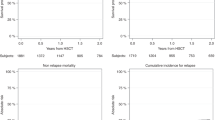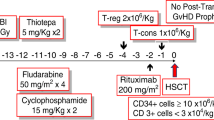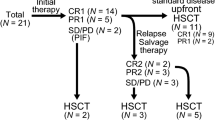Abstract
We included 255 patients from the L.E.A. French long-term follow-up cohort. All had received hematopoietic stem cell transplantation (HSCT) and/or testicular radiation for childhood acute leukemia and were older than 18 years at last L.E.A. evaluation. Total testosterone deficiency was defined as a <12 nmol/l level or by substitutive therapy, partial deficiency as normal testosterone with elevated luteinizing hormone (>10 UI/l). After myeloablative total body irradiation (n = 178), 55.6% had total deficiency, 15.7% partial deficiency, and 28.7% were normal. A 4–6 Gy testicular boost and a younger age at HSCT increased significantly the risk. After a Busulfan-containing myeloablative conditioning regimen (n = 53), 28.3% had total deficiency, 15.1% partial deficiency, 56.6% were normal (62.5% vs. 0% in patients without or with additional testicular radiation). A 24-Gy testicular radiation without HSCT induced total or partial deficiency in 71.4% and 28.6%, respectively (n = 21). Total testosterone deficiency increased the risk of metabolic syndrome: 25% vs. 12.1% in men with partial testosterone deficiency and 8.8% when Leydig cell function was normal (p = 0.031).
This is a preview of subscription content, access via your institution
Access options
Subscribe to this journal
Receive 12 print issues and online access
$259.00 per year
only $21.58 per issue
Buy this article
- Purchase on SpringerLink
- Instant access to full article PDF
Prices may be subject to local taxes which are calculated during checkout
Similar content being viewed by others
References
Berbis J, Michel G, Baruchel A, Bertrand Y, Chastagner P, Demeocq F, et al. Cohort profile: the French childhood cancer survivor study for leukaemia (LEA Cohort). Int J Epidemiol. 2015;44:49–57.
Khera M, Adaikan G, Buvat J, Carrier S, El-Meliegy A, Hatzimouratidis K, et al. Diagnosis and treatment of testosterone deficiency: recommendations from the Fourth International Consultation for Sexual Medicine (ICSM 2015). J Sex Med. 2016;13:1787–804.
Grundy SM, Cleeman JI, Daniels SR, Donato KA, Eckel RH, Franklin BA, et al. Diagnosis and management of the metabolic syndrome: an American Heart Association/National Heart, Lung, and Blood Institute Scientific Statement. Circulation. 2005;112:2735–52.
Reulen RC, Zeegers MP, Jenkinson C, Lancashire ER, Winter DL, Jenney ME, et al. The use of the SF-36 questionnaire in adult survivors of childhood cancer: evaluation of data quality, score reliability, and scaling assumptions. Health Qual Life Outcomes. 2006;4:77.
Bakker B, Massa GG, Oostdijk W, Van Weel-Sipman MH, Vossen JM, Wit JM. Pubertal development and growth after total-body irradiation and bone marrow transplantation for haematological malignancies. Eur J Pediatr. 2000;159:31–7.
Kenney LB, Cohen LE, Shnorhavorian M, Metzger ML, Lockart B, Hijiya N, et al. Male reproductive health after childhood, adolescent, and young adult cancers: a report from the Children’s Oncology Group. J Clin Oncol. 2012;30:3408–16.
Borgmann-Staudt A, Rendtorff R, Reinmuth S, Hohmann C, Keil T, Schuster FR, et al. Fertility after allogeneic haematopoietic stem cell transplantation in childhood and adolescence. Bone Marrow Transpl. 2012;47:271–6.
Oudin C, Berbis J, Bertrand Y, Vercasson C, Thomas F, Chastagner P, et al. Prevalence and characteristics of metabolic syndrome in adults from the French childhood leukemia survivors’ cohort: a comparison with controls from the French population. Haematologica 2018;103:645–54.
Tam FI, Huebner A, Hofbauer LC, Rohayem J. Effects of adolescence-onset hypogonadism on metabolism, bone mineral density and quality of life in adulthood. J Pediatr Endocrinol Metab. 2015;28:1047–55.
Traish AM, Haider A, Doros G, Saad F. Long-term testosterone therapy in hypogonadal men ameliorates elements of the metabolic syndrome: an observational, long-term registry study. Int J Clin Pract. 2014;68:314–29.
Gunn ME, Lähteenmäki PM, Puukko-Viertomies LR, Henriksson M, Heikkinen R, Jahnukainen K. Potential gonadotoxicity of treatment in relation to quality of life and mental well-being of male survivors of childhood acute lymphoblastic leukemia. J Cancer Surviv. 2013;7:404–12.
Shiraishi K, Oka S, Matsuyama H. Assessment of quality of life during gonadotrophin treatment for male hypogonadotrophic hypogonadism. Clin Endocrinol. 2014;81:259–65.
Acknowledgements
The study was funded by the French National Clinical Research Program, the French National Cancer Institute (InCA), the “Laurette Fugain” association, the French National Research Agency (ANR), the “Ligue contre le cancer” association, Cancéropôle PACA, the Regional Council PACA, the “111 des arts” association and the French Institute for Public Health Research (IRESP). The authors would like to thank the LEA study group (cf. appendix), for data collection, as well as the patients and their family.
Author information
Authors and Affiliations
Contributions
RL and GP performed research, analyzed data and wrote the paper; GM designed and supervised the research, and participated in writing the manuscript; PS, JB, ZH and PA analyzed data; YB, SD, AC, MP, MT, JK, JD, VG, CP, NS, DP, ST,IP, SA, GL and AB collected data. All authors participated sufficiently in the work to take public responsibility for appropriate portions of the content, revised the manuscript and gave final approval of the manuscript to be published.
Corresponding author
Ethics declarations
Conflict of interest
The authors declare that they have no conflict of interest.
Additional information
Publisher’s note Springer Nature remains neutral with regard to jurisdictional claims in published maps and institutional affiliations.
Supplementary information
Rights and permissions
About this article
Cite this article
Lopez, R., Plat, G., Bertrand, Y. et al. Testosterone deficiency in men surviving childhood acute leukemia after treatment with hematopoietic stem cell transplantation or testicular radiation: an L.E.A. study. Bone Marrow Transplant 56, 1422–1425 (2021). https://doi.org/10.1038/s41409-020-01180-y
Received:
Revised:
Accepted:
Published:
Issue date:
DOI: https://doi.org/10.1038/s41409-020-01180-y
This article is cited by
-
Impact of haematopoietic stem cell transplantation for benign and malignant haematologic and non-haematologic disorders on fertility: a systematic review and meta-analysis
Bone Marrow Transplantation (2025)
-
Teenagers and young adults with a past of allogenic hematopoietic stem cell transplantation are at significant risk of chronic kidney disease
Pediatric Nephrology (2022)



